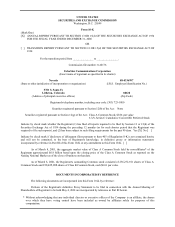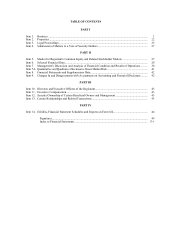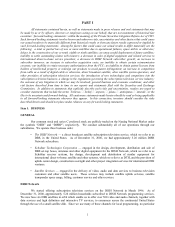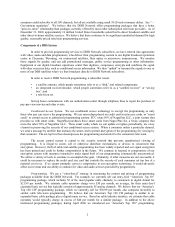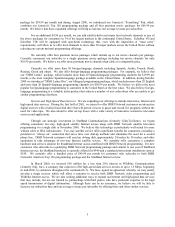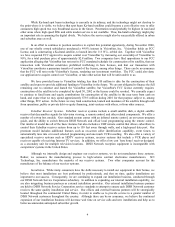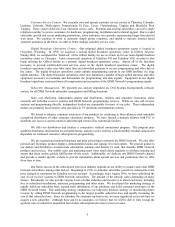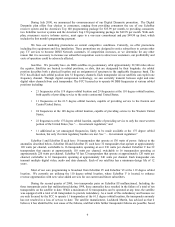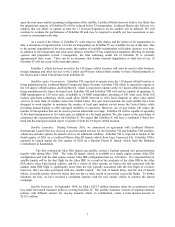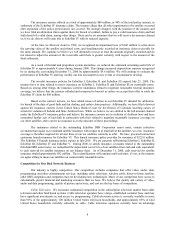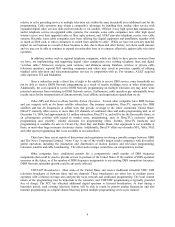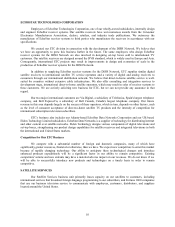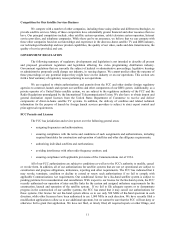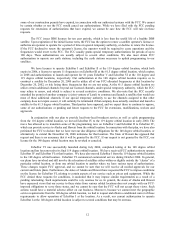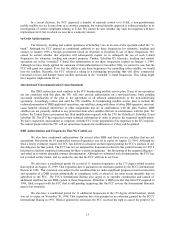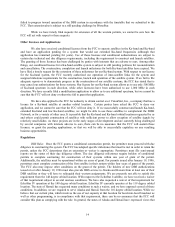Dish Network 2000 Annual Report Download - page 8
Download and view the complete annual report
Please find page 8 of the 2000 Dish Network annual report below. You can navigate through the pages in the report by either clicking on the pages listed below, or by using the keyword search tool below to find specific information within the annual report.6
During July 2000, we announced the commencement of our Digital Dynamite promotion. The Digital
Dynamite plan offers four choices to consumers, ranging from providing consumers the use of one EchoStar
receiver system and the America’s Top 100 programming package for $35.99 per month, to providing consumers
two EchoStar receiver systems and the America’s Top 150 programming package for $49.99 per month. With each
plan, consumers receive in-home service, must agree to a one-year commitment and pay $49.99 up front, which
includes the first month's programming payment.
We base our marketing promotions on current competitive conditions. Currently, we offer promotions
including free equipment and free installation. These promotions are designed to entice subscribers to certain other
pay TV services to become DISH Network customers. If competition increases, or we determine for any other
reason that it is necessary to increase our subscriber acquisition costs to attract new customers, our profitability and
costs of operation could be adversely affected.
Satellites. We presently have six DBS satellites in geostationary orbit approximately 22,500 miles above
the equator. Satellites are located in orbital positions, or slots, that are designated by their longitude. An orbital
position describes both a physical location and an assignment of spectrum in the applicable frequency band. The
FCC has divided each orbital position into 32 frequency channels. Each transponder on our satellites can exploit one
frequency channel. Through digital compression technology, we can currently transmit between eight and nine
digital video channels from each transponder. The FCC licensed us to operate 96 DBS frequencies at various orbital
positions including:
•21 frequencies at the 119 degree orbital location and 29 frequencies at the 110 degree orbital location,
both capable of providing service to the entire continental United States;
•11 frequencies at the 61.5 degree orbital location, capable of providing service to the Eastern and
Central United States;
•24 frequencies at the 148 degree orbital location, capable of providing service to the Western United
States;
•22 frequencies at the 175 degree orbital location, capable of providing service to only the most western
portion of the United States; See “— Government regulation;” and
•11 additional as yet unassigned frequencies, likely to be made available at the 175 degree orbital
location, but only if certain regulatory hurdles are met. See “— Government regulation.”
EchoStar I and EchoStar II each have 16 transponders that operate at 130 watts of power. Subject to the
anomalies described below, EchoStar III and EchoStar IV each have 32 transponders that operate at approximately
120 watts per channel, switchable to 16 transponders operating at over 230 watts per channel. EchoStar V has 32
transponders that operate at approximately 110 watts per channel, switchable to 16 transponders operating at
approximately 220 watts per channel. EchoStar VI has 32 transponders that operate at approximately 120 watts per
channel, switchable to 16 transponders operating at approximately 240 watts per channel. Each transponder can
transmit multiple digital video, audio and data channels. Each of our satellites has a minimum design life of 12
years.
Most of our core programming is broadcast from EchoStar IV and EchoStar VI at the 119 degree orbital
location. We currently are utilizing the 110 degree orbital location, where EchoStar V is located, to enhance
revenue opportunities with new value added services for our current and future subscribers.
During the second quarter of 2000, two transponder pairs on EchoStar III malfunctioned. Including the
three transponder pairs that malfunctioned during 1998, these anomalies have resulted in the failure of a total of ten
transponders on the satellite to date. While a maximum of 32 transponders can be operated at any time, the satellite
was equipped with a total of 44 transponders to provide redundancy. As a result of this redundancy and because we
are only licensed by the FCC to operate 11 transponders at the 61.5 degree orbital location, the transponder anomaly
has not resulted in a loss of service to date. The satellite manufacturer, Lockheed Martin, has advised us that it
believes it has identified the root cause of the failures, and that while further transponder failures are possible, based

